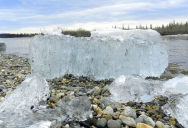If You Ever Come Upon The Beautiful “Candle Ice” On Northern Lakes, Enjoy Its Amazing Sounds But Do Not Try To Walk On It

When most people think of ice, they think of little cubes that they put in their drink, or possibly massive icebergs in the arctic.
While those are certainly common, there are some types of less common ice that are interesting and beautiful.
For those living (or visiting) Northern areas like Canada, Northern Michigan, Japan, and Russia, candle ice (also called needle ice) is a fun phenomena.
This ice forms when the temperature drops and the water starts to freeze.
When the water is supercooled in a way that lets it reach temperatures below freezing while remaining a liquid (due to motion, contaminants, etc), the conditions are set for candle ice.
Water begins to crystalize very rapidly once the actual freezing begins. Rather than freezing in one flat sheet like you might see during the winter in more southern areas, this ice freezes in large columns.
The horizontal pieces of ice are compressed together as more and more of these ‘candle sticks’ form.

Once the lake or other body of water is fully frozen, it can have jagged pieces of ice sticking up all over, or it may also look flat due to rain or snow forming on top.
It is important to note that candle ice is far weaker than traditional ice on a lake, so you won’t want to walk on it, even if it looks thick.
Once spring comes along and the ice starts to melt, things get even more fun with candle ice.
When the water is in motion, either due to wind, underwater currents, or a person throwing something in, the pieces of candle ice clink together making a beautiful clinking sound.
You can hear it in this video, where someone is kayaking through mostly melted candle ice:
Who knew water could freeze in such interesting ways?
If you thought that was interesting, you might like to read about a second giant hole has opened up on the sun’s surface. Here’s what it means.

Sign up to get our BEST stories of the week straight to your inbox.




